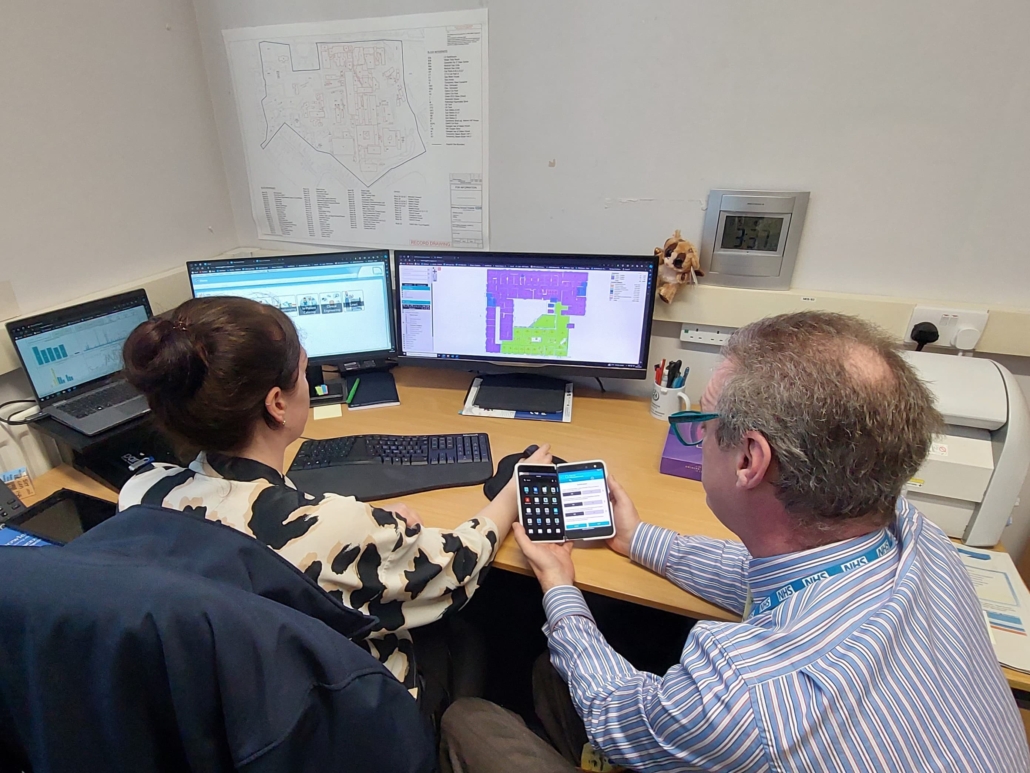How optimised space management can support hospital efficiency
Faced with overcrowding, underinvestment, and the pandemic’s impacts, NHS hospitals are seeking innovative ways to optimize their overburdened facilities. Penny Brinsley looks at one promising solution: Strategic space management enabled by specialized software.

Penny Brinsley
By carefully tracking space utilization across their estates, hospitals can identify underused areas for repurposing, allowing limited resources to be focused on critical patient care services. With integrated facility management systems providing data-driven insights, intelligent space planning represents an affordable avenue for incrementally improving operations amid severe capacity constraints.
The NHS operates over 1,500 hospitals, covering 25 million square meters – the equivalent of 3,500 football pitches. These facilities need to operate every hour of every day, throughout the year. This complex infrastructure requires significant resources, but after a decade of underinvestment and the challenges of the pandemic, estate teams are scrambling to catch up, rather than making proactive improvements.
In February, the NHS Confederation released a report with five areas the Government should focus on. One recommendation is to develop a new long-term capital strategy about more than just fixing roofs but investing in the entire NHS infrastructure. This includes buildings, medical equipment, IT and digital tools.
This investment would of course be warmly received, but realistically NHS Trusts will have to continue to make do for the foreseeable future. Optimising operations through strategic space management within existing estates is one way Trusts can improve their services.
Since the pandemic, increased remote working of non-clinical staff has freed up admin space, and last year the National Health Executive reported that the NHS could create space for 10,000 extra beds by storing patient records offsite. This space is critical for hospital operation, especially when accident and emergency wait times and overcrowding have caused excessive deaths in post-pandemic Britain.
Space management can be a big part of the solution. Space management software allows FMs insight into how all space is being utilised throughout a hospital. Furthermore, when integrated with computer aided facilities management (CAFM) software, users are empowered to make data-driven decisions about their asset maintenance strategy which ultimately helps drive efficiencies and ensures all the space is optimised within your estate.
Patient safety needs to come first. With optimised space management, FM managers and NHS staff can better prioritise their care.
CAFM software
CAFM software streamlines the management of asset, building and maintenance activities. This software is designed, built and delivered to provide a comprehensive and easy-to-use suite of tools to provide insight into the critical performance information of estates. This software is therefore well-suited for the huge variety of healthcare estates because its space measurement and floorplan functionality let users allocate and view all assets via an online platform.
CAFM systems are made to be intuitive and user-friendly so that estate managers and FM teams can understand and use complex data to support their strategic decision-making. Workers are spread widely across hospital estates, so information can also be communicated efficiently to frontline workers through a fully integrated CAFM mobile app. The app keeps a remote workforce in communication with help desk services, further improving efficiency.
Wasted space
Post-pandemic digitalisation and office space relocation have freed up space across the sector. Many administrative workers are now working remotely, using hospital spaces less throughout the working week. For patients too, the NHS app has changed how spaces are used. Piloted in 2018, NHS appointments are now easier than ever to book online or in-app, with over 30 million people signing up in 2023. The ease of booking and managing appointments online has meant that waiting rooms are now quieter, offering a potential to downsize and reallocate some of that space.
Often, the NHS does not track desk utilisation, as the focus is on patients – monitoring the operating theatre use, bed occupancy, use of disabled car spaces are a few examples. When these spaces are left unused, the estate’s return on investment is reduced.
Space management software allows building management teams to make more strategic decisions about building space use, leading to not only greater efficiency but an improved return on investment. By knowing which rooms are not in use and when, estate managers can better allocate appropriate space where needed for more urgent needs.
PAM support
Since the NHS introduced the Premises Assurance Model (PAM) in 2013, there has been a framework in place to support effective estate and facilities management, including self-assessment questions for Safety, Patient Experience, Efficiency, Effectiveness, and Organisational Governance.
PAM allows NHS Trusts to prioritise investment decisions effectively and ensure robust management systems are in place. However, its existence does not guarantee that NHS and FM teams understand the model. Without an understanding of the specific data that needs to be reported, estate teams can be left without important information for the allocation of resources and key performance measurements, rendering them unable to make effective data-driven decisions.
This problem can worsen when asset reporting is not centralised – manual processes for PAM reporting can make it difficult to build a comprehensive view of an estate. Spreadsheets can be disconnected, and reporting technology is often outdated. These issues can extend to terminology too – if one FM states that an asset is a “bathroom,” when another states “toilet,” the data may not show a complete picture.
NHS Trust stakeholders should be educated on PAM, with tailored training sessions and informational campaigns so all teams fully understand its requirements and benefits. Implementing CAFM software can also centralise and streamline this data management and reporting. Our QFM space management software allows users to create a matrix, pre-populate fields with existing data, and from that it can determine costs and risks, creating a backlog for reference. This can prevent the duplication of tasks and reduce disjointed manual reporting.
Case study: Kettering NHS
In 2019 we partnered with Kettering General Hospital NHS Foundation Trust to provide QFM CAFM and space management software for use across its estate. We were chosen because of the software’s ease of use, functional capabilities that align with the requirement of NHS Trusts and its ability to handle the numerous FM tasks required across the estate.
The software was able to help with space occupancy challenges across Kettering’s multiple wards and 560 beds, including patient relocations, and to keep secure, up-to-date information about the estate for relevant compliance regulations.
The software was originally introduced to help the hospital with its FM helpdesk provision and planned predictive maintenance schedules. Since then, it has expanded to include space and move management, our mobile application for operatives in the field, and enhanced asset lifecycle functionality. Now, it has been used to integrate all the building and asset information with floor plans, cleaning schedules, porterage and other estate data, allowing for better workplace productivity and cost benefits. Data is shared within and held securely in a singular centralised software solution.
NHS England’s processes for managing and reporting building developments outline how new building projects should be delivered with Building Information Modelling (BIM). BIM is a modelling technology that can produce, communicate and analyse building models, through intelligent digital representations.
For older estates like Kettering NHS, BIM is critical for the upkeep and efficiency of buildings. By integrating BIM capabilities with QFM, the Trust can manage its building data and drive efficiencies across the real-estate portfolio more accurately. The Trust is digitising its estate by laser scanning several smaller buildings for the project. By digitising its real-estate portfolio and implementing BIM software, the Trust’s everyday maintenance and operations strategy can be optimised.
For Kettering NHS, the use of QFM has made meeting PAM requirements a considerably smoother process. Its software is kept updated in line with relevant governmental guidance, ensuring that it produces the correct reporting for NHS England. Over time, SWG and the Trust have developed a better building system that caters to the specific needs of its diverse NHS estate.
Conclusion
Understanding space utilisation has a multitude of benefits. Hospital estate managers need to encourage and support NHS and FM teams to understand the Premises Assurance Model and work with them to understand the priorities of an estate. From there, hospitals can progress to develop different CAFM modules and install sensors when required. With time, technology like BIM can be implemented to produce even more accurate digitised real-estate portfolios.
The issues hospitals face will not be fixed in the immediate future. These changes need to be long-term and the return on investment needs to be built into major estate management decisions. CAFM software can make estate management smarter throughout the industry.
Patient care is the top priority, and a smoothly run estate leads to improved patient care. Providing a full, real-time overview for estate managers can strengthen the NHS’s infrastructure, allowing them to do just that.
About the Author
Penny Brinsley is an account director at Service Works Global (SWG). SWG is a leading international provider of facilities, property, and workplace management software with offices in the UK, Sweden, Canada, Australia, and the Middle East. SWG is a wholly owned subsidiary of Addnode Group, listed on Nasdaq Stockholm.
Established in 1994, SWG is a Microsoft Gold Partner, certified with ISO 9001 for quality management and ISO 27001 for information security management, and has a wealth of expertise in computer-aided facilities management (CAFM), public-private partnership (PPP), and building information modelling (BIM) software.


